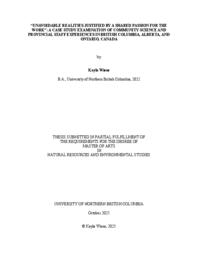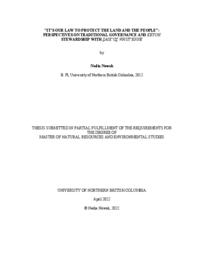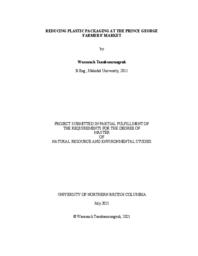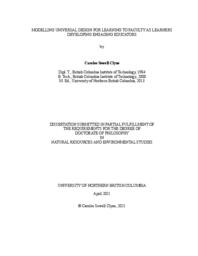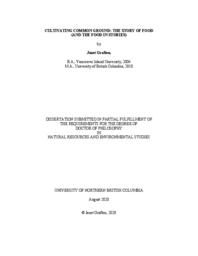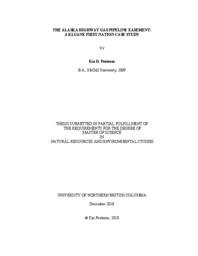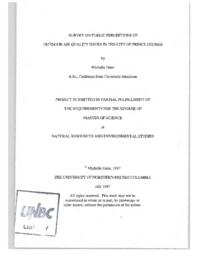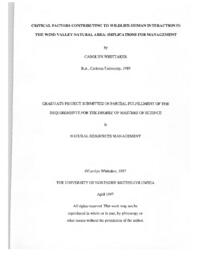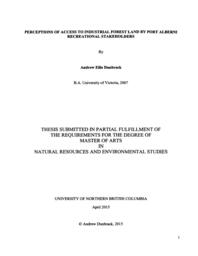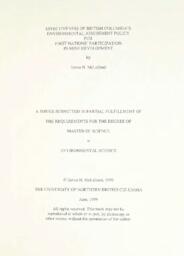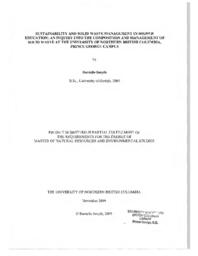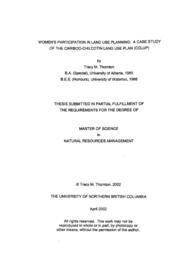Booth, Annie
Person Preferred Name
Annie Booth
Related Works
Content type
Digital Document
Origin Information
Content type
Digital Document
Description / Synopsis
Bear viewing poses significant risks for humans and wildlife, particularly in the form of "bear jams" - traffic congestion caused by people slowing down or stopping to view bears. This study addresses gaps in our understanding of the human dimensions of roadside bear viewing, focusing on the case study of Peter Lougheed Provincial Park (PLPP) in Alberta, Canada. A mixed-methods approach is employed in this study, comprising a survey (n=380) of visitors who have witnessed or engaged in roadside bear viewing and interviews with experts who have experience in bear-related fields (n=22). The main findings indicate that a balanced approach is needed to manage bears and humans. The study suggests human, bear, infrastructure, and habitat-related approaches, including implementing no-stopping zones, enforcing regulations, and improving education and outreach, are key to managing roadside bear viewing. The results of this study provide valuable insight for park managers and wildlife officials to develop effective management strategies that balance the needs of both humans and bears. The data collected in this study underscore the importance of a holistic and adaptive management approach to addressing roadside bear viewing. The findings apply to PLPP and parks facing similar challenges
Origin Information
Content type
Digital Document
Description / Synopsis
Environmental sustainability is key to the long-term sustainability of a business during these times of climate change crises and global warming. Otherwise, survival will be challenging for large carbon emitters. This dissertation travels through carbon accounting to carbon reporting to corporate level environmental sustainability efforts and a firm’s value. It examines whether the corporation-level environmental sustainability efforts increase its value, focusing on Global 500 companies for 2010-2018. Measures used for corporate-level ecological sustainability include the choice of voluntary disclosure, carbon emission amounts, carbon intensity, and carbon disclosure quality. Different proxies used to measure a firm’s value comprise the market value of equity, return on assets, return on equity, Tobin’s Q, and enterprise value. During the study period, those corporations that chose to disclose their carbon-related data on the CDP’s public platform noticed that the market valued their environmental sustainability efforts by increasing their market value – showing the market value-relevant content of voluntary carbon disclosures. Carbon disclosure quality stands out among the proxies used to measure environmental sustainability efforts at a corporate level. Some interesting findings showed that measuring and disclosing Scope 3 emissions must have played a significant role in increasing a firm’s disclosure quality and so its market value. Similar to Assidi's research, this study provides guidelines for investors and managers to increase a firm’s value by using better quality carbon disclosures. This study also compared the firm’s value of disclosing and non-disclosing firms and, unfortunately, did not find any significant relationship between a company’s disclosure decision and market value in the context of global companies. These results are alarming given the current and potential hazards related to climate change and global warming. It seems that investors ignore climate-related urgency and focus on short-term profits. Companies do not find any incentives to reveal their environmental-related information on any public platform such as the CDP. This study examined and found that social pressure, market pressure, economic pressure, legal/institutional pressure, and previous year disclosure make the companies disclose their carbon information to the CDP. Based on the sample of the Global 500, the results support the notion that larger firms are aware of their social responsibility. So, they disclose environmental-related information voluntarily even in the absence of any mandatory requirement. Furthermore, high-levered firms are more likely to release their carbon-related information. However, the results report that a large proportion (25%) of the sample companies chose not to disclose carbon information. Also, this study showed that regulatory provisions had an observable influence on a company’s disclosing decision. These policies can force companies to reduce carbon emissions and make carbon disclosures their strategic priority. This study emphasized the impact of carbon disclosures, related information, their link to a firm’s value, and corporate-level environmental sustainability efforts. It also posits that corporation-level carbon disclosures can be a prerequisite to corporation-level ecological sustainability. In addition, these disclosures can serve as necessary and valuable environmental-related information for existing and potential investors and other interested stakeholders such as nongovernmental organizations (NGOs), governments, policymakers, accountants, sustainability experts, and researchers. On positive notes, around fifty-five percent of the corporations whom CDP approached for their environmental-related disclosures in 2010 reported to the CDP for the study period, to indicate that these firms are already in the war against climate change and working on business and environmental sustainability. Moreover, these efforts could pay off more in a mandatory environmental-related disclosure regime provided that these disclosures include all scope of emissions. Therefore, this study recommends that environmental-related disclosures be required as part of a company’s annual reports to be more informative for current and potential investors. Moreover, standards of environmental sustainability are needed from standard setters’ bodies to guide the companies to provide consistent and accurate information in their annual reports so that investors can make informed investment decisions.
Origin Information
Content type
Digital Document
Description / Synopsis
The traditional governance system of S̲aik’uz̲ Whut’enne is rooted in a deep relationship with their Keyoh – their homelands that sustain all life, including the waters, rocks, mountains, plants and animals. Based in S̲aik’uz̲’s inherent Rights and Title, as well as the legal and political context of the United Nations Declaration on the Rights of Indigenous Peoples and evolving Aboriginal case law, this research explores the key institutions and principles of S̲aik’uz̲ traditional governance. Alongside this, it challenges the ways that colonization has disrupted and eroded S̲aik’uz̲ traditional governance through its attempt to remove S̲aik’uz̲ Whut’enne from their Keyoh, impose a colonial Western system of land management, and outlaw their governance system, the Balhats. Informed by decolonizing and Indigenous methodologies, this research has been developed and carried out in collaboration with the S̲aik’uz̲ First Nation and uses qualitative methods including archive and document review, semi-structured interviews, and group review meetings. It offers insights about the persistence of S̲aik’uz̲ Whut’enne against colonial forces, and the ways that S̲aik’uz̲ traditional governance is alive, evolving across time, and of utmost relevance to the present and future.
Origin Information
Content type
Digital Document
Description / Synopsis
Plastic pollution, a global problem, contributes to detrimental impacts on the environment. To mitigate plastic pollution locally,farmers’ market scan play a role in reducing plastic consumption. Many studies have suggested that customers and vendors are aware of environmental problems. Yet vendor environmental awareness does not always result in appropriate actions, as many vendors still rely on plastic packaging. To investigate the reasons for such reliance, I conducted vendor interviews and a customer survey at the Prince George (B.C.) Farmers’ Market. The results show that the barriers to reducing plastic include packaging availability, characteristics, functions, and price. Based on interview results, I developed a manual to support vendors interested in reducing plastic packaging at their stalls. I also offer recommendations as to how policy makers can motivate vendors and customers to reduce plastic consumption, such as offering customers reusable bags and organizing plastic-free events.
Origin Information
Content type
Digital Document
Description / Synopsis
The question explored through this research study is: Does modelling Universal Design for Learning to university faculty as learners deepen their engagement as educators? Through providing training where faculty themselves are learning about Universal Design for Learning (UDL) through a UDL modelled environment (CAST, 2018b; Meyer, Rose, & Gordon, 2014), this research project investigates if this experience translates into a stronger role as educators for these faculty. Participants in this research project are faculty members teaching in disciplines associated with Natural Resources and Environmental Studies. Through a virtual World Café, participants of the workshop shared their reflections and experiences as they learned about learning. Using the UDL framework’s horizontal organization, as conceptualized by CAST, as a lens, participant reflections were themed to determine their progression towards learning and understanding the UDL framework in this context. Evaluation of this research data indicated that faculty in this study are located along UDL Access and Build rows of the UDL Guidelines reflecting a novice learning stage where greater cognitive energy is required (Posey, 2019a, 2019b). This knowledge provides evidence that professional development opportunities should support strategies and provide the guidance necessary to foster their skills towards the UDL goal of becoming an expert learner. Elevating faculty to the UDL expert teacher level in this context enhances their skills and understanding in their creation of inclusive learning environments for their classrooms (Meyer, Rose, & Gordon, 2014).
Origin Information
Content type
Digital Document
Description / Synopsis
Demystifying the story of food – from seed to store to stomach and how that cycle perpetuates – is a core tenet of food literacy and the central aim of this project. While exposure to environmental issues is critical to developing awareness, young learners are often burdened with crisis-laden facts about the state of our world and our food systems. Approaching difficult subjects using a narrative approach is one way to mitigate this burden. In this project, children’s literature that centres on farms and food production/food gathering in settler and Indigenous contexts is used as a launching pad for discussions about food security. Food is an enduring theme in children’s and young adult literature, and is particularly prevalent in narratives from the past, where food gathering and production are often rooted in their environmental contexts. These food narratives provide a pathway for young readers to critically investigate contemporary environmental concerns from a safe space. This project investigates how children’s literature can be used as part of a critical food pedagogy to enhance the food literacy of young learners and encourage them to find common ground between the physical world and the worlds they read. In locating, analyzing, and experiencing food environments in literature via an affective, indirect approach, food literacy - which is foundational to the development of environmentally responsible behaviour – is enhanced.
Origin Information
Content type
Digital Document
Description / Synopsis
Biocultural approaches to conservation include the protection and appreciation of other ways of knowing the environment. Studies in traditional resource management systems illuminate the intricate ways culture has coevolved with nature and provide opportunities to incorporate alternate perceptions of the environment into conservation objectives. This thesis examines how traditional resource management systems contribute to biocultural conservation using a case study for the relationship between Tr’ondëk Hwëch’in First Nation, caribou and Tombstone Territorial Park. Core beliefs about the natural world, including caribou, are central to the strategies Tr’ondëk Hwëch’in employ in resource management. While cultural values and First Nation rights are engrained in park management, a broader understanding of how Tr’ondëk Hwëch’in know the natural world is lacking.
Origin Information
Content type
Digital Document
Origin Information
Content type
Digital Document
Origin Information
Content type
Digital Document
Origin Information
Content type
Digital Document
Origin Information
Content type
Digital Document
Origin Information
Content type
Digital Document
Origin Information
Content type
Digital Document
Origin Information
Content type
Digital Document
Origin Information
Content type
Digital Document
Origin Information
Content type
Digital Document
Origin Information
Content type
Digital Document
Origin Information
Content type
Digital Document
Origin Information
Content type
Digital Document
Origin Information
Content type
Digital Document
Origin Information
Content type
Digital Document
Origin Information
Content type
Digital Document
Origin Information
Content type
Digital Document
Origin Information

